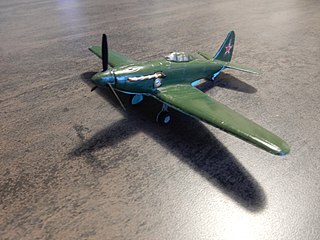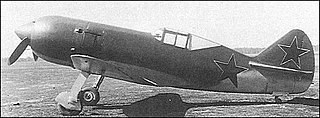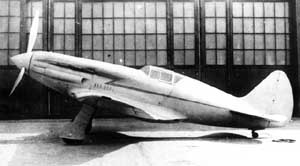
The Mikoyan-Gurevich I-250 was a Soviet fighter aircraft developed as part of a crash program in 1944 to develop a high-performance fighter to counter German turbojet-powered aircraft such as the Messerschmitt Me 262. The Mikoyan-Gurevich design bureau decided to focus on a design that used something more mature than the jet engine, which was still at an experimental stage in the Soviet Union, and chose a mixed-power solution with the VRDK motorjet powered by the Klimov VK-107 V12 engine. While quite successful when it worked, with a maximum speed of 820 km/h (510 mph) being reached during trials, production problems with the VRDK fatally delayed the program and it was canceled in 1948 as obsolete.
The Klimov M-106 was an experimental liquid-cooled V12 piston aircraft engine intended for Soviet aircraft during World War II.

The Klimov VK-107 was a V-12 liquid-cooled piston aircraft engine used by Soviet aircraft during World War II.

The Mikulin AM-34 (M-34) was a Soviet mass-produced, liquid-cooled, aircraft engine. Before the Great Patriotic War, the Soviet aeroengine industry was mainly engaged in producing foreign designs, notably Wright, Bristol, Hispano-Suiza, and Gnome-Rhône. Several engines of so-called original design were developed, although these were probably largely based on foreign models. The M-34 was thought to have been originally designed in Italy by Fiat; it closely follows Italian in-line aeroengine practice. Its initial development was troubled, but it eventually became one of the most successful Soviet aircraft engines of the 1930s. It was utilized on numerous aircraft, including the Beriev MBR-2, Tupolev TB-3, Tupolev TB-4, Tupolev ANT-20, Petlyakov Pe-8, Kalinin K-7, Polikarpov I-17, and Bolkhovitinov DB-A, as well as the G-5 and various prototype motor torpedo boats. A version of the maritime model was adapted for use in several prototype heavy tanks in 1939, although none was placed into production.

The Mikulin AM-35 was a 1930s Soviet piston aircraft engine. Derived from the AM-34FRN, the AM-35 entered production in 1940 and was used on the MiG-1 and MiG-3 World War II fighters as well as the Petlyakov Pe-8 heavy bomber.

The Mikulin AM-38 was a 1940s Soviet aircraft piston engine. It was a further development of the Mikulin AM-35 design. The AM-38 was used on the Il-2 Shturmovik and Il-10 ground attack aircraft. The AM-38 was installed experimentally in a MiG-3 and tested during August 1941. A slight performance improvement was seen at low-altitude but the engine experienced overheating problems due to the cooling and oil systems remaining unchanged from the AM-35A.
The Mikulin AM-39 was a 1940s Soviet aircraft piston engine. Representing a high-output version of the AM-35A, AM-39 was used on the Mikoyan-Gurevich I-220 and Polikarpov ITP fighters, and the Tupolev SDB bomber.

The Mikulin AM-42 was a 1940s Soviet aircraft piston engine designed by Alexander Mikulin. Representing a high-output version of the AM-38F, the AM-42 was used in the Ilyushin Il-1 fighter, and the Il-8 and Il-10 ground attack aircraft.

The Sukhoi Su-1 or I-330 was a prototype Soviet high-altitude fighter aircraft built at the beginning of World War II. An improved version, designated Su-3 (I-360), was also built and tested the following year. Neither version was mass-produced.

The Mikulin M-17 was a Soviet-licensed copy of the German BMW VI V-12 liquid-cooled aircraft piston engine, further developed by Alexander Mikulin and used by Soviet aircraft during World War II. Production began in 1930 and continued through 1942. More than 27,000 were produced, of which 19,000 were aircraft engines while the rest were used in Soviet tanks of the period.

The Klimov M-103 is a V12 liquid-cooled piston aircraft engine used by Soviet aircraft during World War II.
The Shvetsov ASh-73 was an 18-cylinder, air-cooled, radial aircraft engine produced between 1947 and 1957 in the Soviet Union. It was primarily used as the powerplant for the Tupolev Tu-4 heavy bomber, a copy of the American Boeing B-29 Superfortress.

The Mikoyan-Gurevich I-211 was a prototype high-altitude Soviet fighter aircraft built during World War II. It was a version of the Mikoyan-Gurevich I-210, itself a variant of the Mikoyan-Gurevich MiG-3, fitted with a Shvetsov ASh-82F radial engine. Its development was quite prolonged, although successful, but by the time it finished its manufacturer's trials in early 1944 there was no need for a high-altitude fighter and it was not worth reducing the production of existing fighters to convert a factory over to the I-211.

The Charomskiy ACh-30 was a Soviet aircraft diesel engine developed during World War II. The initial version was not very satisfactory and it was cancelled when its factory was forced to evacuate in the autumn of 1941. But production was reinitiated in the summer of 1942 and continued until September 1945 to meet the need for an economical engine to power the Soviet long-range bombers like the Petlyakov Pe-8 and the Yermolayev Yer-2.
The Charomskiy M-40 was a Soviet turbocharged aircraft Diesel engine developed during World War II. It was used in a few Petlyakov Pe-8 heavy bombers until August 1941 when it was removed, because it was unreliable at high altitudes. The engines were stored until 1944 when they were disassembled and their components were used in the closely related Charomskiy ACh-30B.
The Shvetsov M-71 was a Soviet radial engine built in small numbers during World War II. It was derived from the Shvetsov M-25, which was a license-built copy of the American Wright R-1820-F3 Cyclone engine.

The Polikarpov TIS was a heavily armed Soviet heavy fighter designed during the early 1940s. Competing contemporaneous designs in the USSR included the Grushin Gr-1, Mikoyan-Gurevich DIS and Tairov Ta-3.
The Klimov M-120 was a Soviet prototype 18-cylinder liquid-cooled inline aircraft engine designed during the early years of World War II. Testing did not go well and it was cancelled in 1942.






















